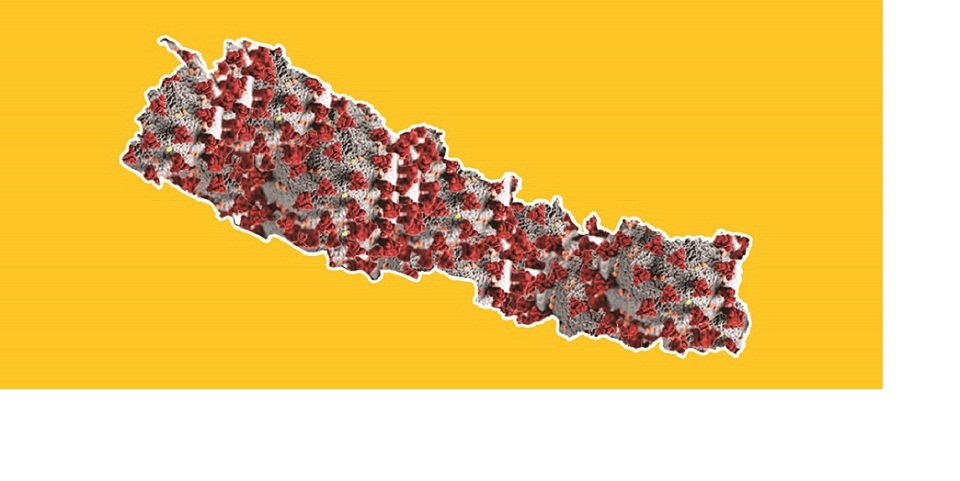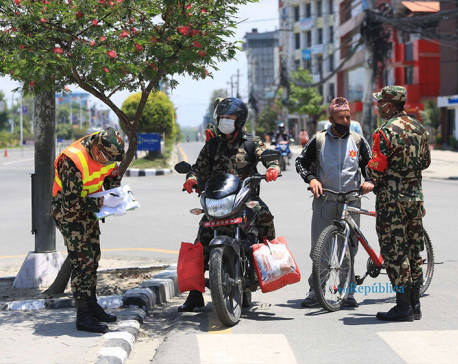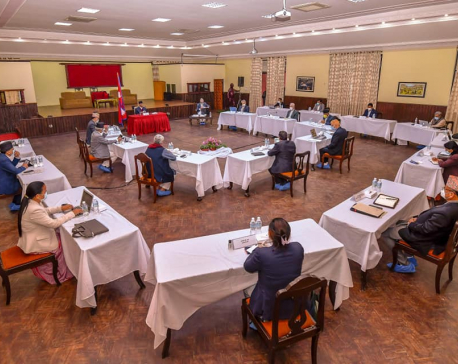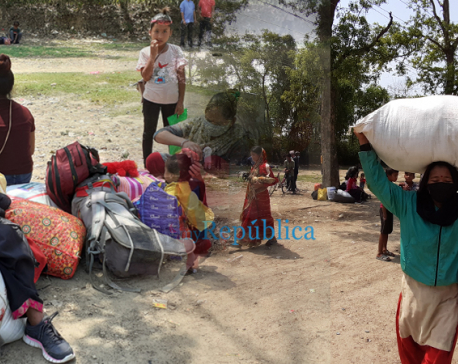
OR
Transition in crisis: COVID-19 and federalisation in Nepal
Published On: July 23, 2020 06:39 PM NPT By: Iain Payne


Iain Payne
Iain Payne is associated with Niti Foundation. With thanks to George Varughese who provided comments on a previous draft.news@myrepublica.com
More from Author
The Nepali federation is still in its infancy. Less than five years from its establishment in the 2015 Constitution and less than three years from elections in 2017 that instated new federal institutions, the transformation of the erstwhile highly centralised, unitary Nepali state into a three-tiered federal system made up of 761 semi-autonomous nodes of power (753 local units, seven provinces, and the federation) remains very much a work in progress.
Following the 2015 earthquakes and floods in 2018, the federalisation of the Nepali state continues amidst yet another crisis. And as the country emerges from an 82-day lockdown, the continued rapid growth of COVID-19 infections (as of 15 July, 17,177 cases have been detected with 39 fatalities) is but one sign of what is increasingly seen to be a mismanaged governmental response.
As comparative constitutional lawyers consider and contrast state responses to the COVID-19 pandemic, the territorial dimension of governmental action — that is, where authority to make decisions resides — has surfaced as one key theme of discussion. While scholars of multi-level governance have generally espoused the positive ways in which federal and decentralised systems have faced the challenges posed by COVID-19 (see, for example, the series curated by the UACES Research Network and Forum of Federations), scepticism towards such arrangements — in mass media and among general publics — has also been visible. While those assessing the efficacy of federal systems have pointed to the ways in which devolution has, among other things, supported more reactive and localised responses and even enhanced national decision-making; for those questioning federalism, the multiplicity of power centres undermines the capacity of states to respond swiftly and robustly to the COVID crisis.
The contours of this debate are present in the Nepali discourse. In the early months of the pandemic, media has pointed out, for example, how clear communication of reliable health information has been compromised by a cacophony of statements emerging from all the three tiers of the Nepali federation; and some commentators have argued that the lack of clarity around the role of the country’s provinces in the current crisis reveals their general redundancy. Conversely, others have declared federalism to be the ‘clear winner’ of the crisis and diagnose failures in the Nepali state’s response as stemming from the federal government’s reluctance to more fulsomely devolve power to provincial and local decision-makers.
While ‘more governments mean more confusion’ or ‘mitigating the failures of the central government’ are simple messages that encapsulate much of the opinion at either end of the spectrum of debate, both messages are also simplistic. As the comparative experience highlights, dynamics such as quality of governance and trust in government are likely to be the more important determinants of a state’s relative success in overcoming the challenges posed by COVID-19. Indeed, multi-level governance structures do not stand in a vacuum; as Francesco Palermo has reminded us, ‘[f]ederalism… is in the end an accelerator. It tends to increase efficiency when this is already given, and it adds to confusion when this is the prevailing mood. Like any other constitutional tool, it cannot stand alone.’
It is thus crucial to frame analysis of the federal dimension of the response to COVID-19 in Nepal within the country’s broader constitutional context. Indeed, rather than simply asking whether the reverberations of the crisis appear to justify or speak against the adoption of a federal system in Nepal — an exercise which in most cases seems merely to validate authors’ pre-existing dispositions on the still contentious issue of federalism — a more constructive line of analysis is to understand and reflect on what the current crisis reveals about the unfolding process of federalisation. Three months from the onset of the COVID-19 pandemic in Nepal, the governmental response is helping to bring at least three observations about the country’s federal transformation into sharper focus.
Incomplete federalisation
For one, the crisis is revealing the extent to which Nepal’s federal transformation remains incomplete. This is particularly noticeable at the provincial level where the construction of governance architecture languishes and remains inadequate. Still having to navigate ill-suited administrative structures imposed on them by the federal government’s organisation and management survey (pp 8, 13), the seven up-start provinces are severely impeded by limited physical infrastructure and human resources (pp 14-16). Indeed, it is noticeable that provincial government capital expenditure in 2018-19 only reached 30 percent of budgeted projections (p 16), less than half that of the federal government’s budget utilisation in the same period. Provinces simply do not have the institutional capacity to absorb the revenue allocated to them.
Organisational deficiencies are compounded by the still-ambiguous role for provinces in Nepal’s ‘hourglass’ federal arrangement — in which the central and local governments have robust and clearly defined powers while provinces are a comparatively weaker intermediate tier. In lieu of a coherent transition management plan to guide the ‘unbundling’ of the Constitution’s vertical division of power, the jurisdictional responsibility of each tier remains unclear in many regards. This has been exacerbated by the centrally-driven delay of important elements of subnational legal architecture in areas such as policing and healthcare (pp 18-19) and, as has been noted in relation to disaster management, even where legislation has been put in place jurisdictional confusion continues (p 6).
The conjuncture of organisational incapacity and jurisdictional uncertainty has resulted in the emergence of a disorganised provincial architecture of government that is still struggling to fit itself for purpose. Thus, as the COVID-19 crisis emerged, provinces were severely under-equipped. Only three of seven provinces, for example, had established disaster management committees (p 24); and as COVID-19 cases began to be detected, the Health Office and Health Directorate in Far West Province — the bodies responsible for overseeing the Province’s health response, including undertaking contact tracing — had just seven employees between them. Against this backdrop, it is unsurprising that the provincial governments have been unable to effectively respond to the spread of COVID-19. Rather than acting as strategic aggregators of information and coordinating regionalised responses, provincial governments have largely been confined to channelling funds to local governments.
Weak intergovernmental relations
Secondly, crisis governance is highlighting the weakness of intergovernmental relations in Nepal. It is clear that basic coordination errors have hampered a unified and coherent pandemic response and driven policy confusion. With the Intergovernmental Relations Bill yet to be passed into law by the federal parliament, a significant element of the formal legal architecture to guide coordination and cooperation among the country’s 761 governments is not in place. Intergovernmental relations throughout the crisis have thus been characterised by reactive and ad hoc decision-making that has lacked transparency. While on 11 April Prime Minister KP Oli convened a virtual meeting with the seven provincial chief ministers, no forum has been convened since to bring federal and provincial leadership together. Similar intra-provincial coordination councils have not met since the crisis began.
The need for coordination is perhaps most clearly required for the successful execution of the quarantine system, a central plank of Nepal’s COVID-19 response that seeks to ensure that hundreds of thousands of migrants are able to return to their communities safely without spreading the virus. Judged by the outcomes, however, the system has been a failure. Not only have many evaded the quarantine process entirely, confinement bubbles have been broken, and inadequate facilities have been unable to provide basic food and shelter for those required to enter into their care. Most troublingly, quarantine facilities themselves have become the locus for the super-spread of the virus.
While the management of these facilities is a role that sits with local governments, local governments have complained that they have not been provided sufficient guidance nor resources by their provincial and federal counterparts. Meanwhile, the federal government has criticised sub-standard accommodation and procedures put in place by local governments, and provincial governments have demanded local units increase capacity to house more returnees. The federation’s higher-order governments are perceived by many to have sought to evade accountability by passing the heavy burden of responsibility for the quarantine system onto ill-equipped local governments. There are many other examples of communication breakdown, duplication of functions, and unilateral action, which have only injected further incoherence into the already faltering state response.
Emerging power centres
Thirdly — and more positively for the health of the federal project in Nepal — the crisis is shining a light on the development of new power centres to rival Kathmandu. As Kathmandu-based politicians have once again demonstrated their inclination to place narrow, self-interested factional politics ahead of the national interest, local and provincial governments have been compelled to shoulder significant burdens of responsibility in managing the crisis response. In contrast to the federal administration, which was unable to implement adequate measures to prevent returning migrants from carrying the disease into the country — even as international borders were supposed to be closed — local governments initiated door-to-door health campaigns to identify and quarantine recently returned migrants. Similarly, when the federal government, after announcing that it would support local governments to distribute relief to the most vulnerable, failed to transfer the money, the provinces stepped up to provide financial relief to local administrations.
Moreover, the objection by several provincial and local government leaders on 9 April to the federal government’s unilateral decision to allow those stranded in Kathmandu to return en masse to villages throughout the country is noteworthy. Within hours of the disclosure of the federal government’s intentions, a collective outcry from subnational governments appeared to force the federation into a policy U-turn. In the subsequent weeks, the internal repatriation of some 100,000 migrant workers and students occurred largely on the terms of local and provincial governments, which chartered buses to bring people home.
In light of the legacy of centralised and hierarchical decision-making emanating from Kathmandu, which has continued to shape Nepal’s early federal experience, this public repudiation and bringing of federal government decision-makers into compliance by a collection of non-Kathmandu-based actors is significant and may be an important sign that the devolution of power from elite-captured Kathmandu institutions is taking root.
Bringing issues into focus
The way that governance systems react under pressure reveals something important about their nature. As Scott Stephenson recently noted in relation to the COVID-19 pandemic: ‘emergencies sometimes present vivid illustrations of constitutional issues that are sometimes otherwise difficult to see in their full form. They often highlight pre-existing limitations, gaps and tensions in the system of government, rendering them more visible to us.’ And so, while the three observations highlighted in this article are by no means novel — these issues have been, and no doubt will continue to be, central to ongoing analysis of federalism in Nepal — the governmental reflex induced by the weight and immediacy of the COVID-19 pandemic provides an important moment to examine Nepal’s federal development.
Not only is the crisis providing concrete examples to illustrate the incomplete state of institutional transformation and development, it is also clearly demonstrating the cost of the delayed federal transition. While the ‘cost’ of federalism in Nepal is almost exclusively discussed in terms of the financial burden borne by taxpayers to sustain an additional provincial layer of government, an ineffectual governmental response to the pandemic — both as regards public health and the economy — is clearly a more substantial burden for Nepali citizens to bear. And while, as highlighted above, ineffectual government is not a cost inherent to multi-level governance, the poor sequencing of Nepal’s transition to federalism and the weak state of intergovernmental relations have, at least in some regards, degraded the quality of subnational governance and are compounding the state’s lacklustre pandemic response.
Similarly, more than simply showing how the burden of governance has been pushed down to subnational governments, the COVID crisis is highlighting how they are rising — albeit falteringly — to the challenge. The crisis thus stresses the need to reframe how government capacity is conceived in the Nepali discourse. While in many instances the presumed-to-be-capable centralised institutions have been found wanting, despite their significant capacity limitations and own deficiencies, subnational governments, local governments in particular, have shown far greater ability to be nimble in responding to the crisis.
Finally, perhaps one of the main lessons of the COVID crisis, which can be traced through the three observations highlighted here, is the gap between the constitutional tools available and governance in practice. While the 2015 Constitution provides a robust blueprint for federated government in Nepal, the concerns highlighted here do not emanate from deficiencies in the text itself but rather from a political resistance to invest in the institutions required to see federalism flourish. The aversion to allow constitutional law to shape governance practice, of course, is nothing new — constitutionalism has long been a beleaguered ideal in Nepal where an informal, ad hoc and opaque governance culture predominates, democratic practice remains immature, and the rule of law has historically been weak. And thus, while the pandemic is a transformative force, we must not lose sight of the ways in which Nepal’s constitutional system emerges from the shock of the crisis unchanged. For it is the stickier elements of constitutional practice — the diminishing of constitutionalism and centralised resistance to devolution, chief among them — that will have the most enduring influence on the shape and future of Nepali federalism.
Iain Payne is associated with Niti Foundation. With thanks to George Varughese who provided comments on a previous draft.
This article was originally published as part of the ‘Asian Legal Conversations - COVID-19’ series hosted by the Asian Legal Centre at Melbourne Law School.
You May Like This

PHOTOS: Nepal Army ups vigilance against misuse of combat dress during lockdown
KATHMANDU, May 18: Nepal Army has started inspection in various parts of the capital in a bid to check the... Read More...

Lockdown extended until May 7
KATHMANDU, April 26: A meeting of the Council of Ministers on Sunday evening has decided to extend the ongoing nationwide... Read More...

Ignoring coronavirus, people are braving long journey back home
KOHALPUR, April 24: Janakala Malla of Gamgadhi-1, Mugu had come to Nepalgunj for treatment a month ago. Before she was... Read More...










Just In
- Heavy rainfall likely in Bagmati and Sudurpaschim provinces
- Bangladesh protest leaders taken from hospital by police
- Challenges Confronting the New Coalition
- NRB introduces cautiously flexible measures to address ongoing slowdown in various economic sectors
- Forced Covid-19 cremations: is it too late for redemption?
- NRB to provide collateral-free loans to foreign employment seekers
- NEB to publish Grade 12 results next week
- Body handover begins; Relatives remain dissatisfied with insurance, compensation amount







Leave A Comment